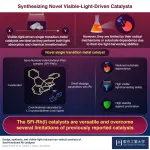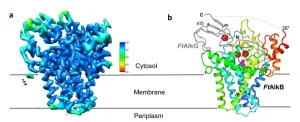An improved, visible light-harvesting catalyst to speed up reactions
2023-03-30
(Press-News.org) Photocatalysis is the use of light to accelerate the rate of a reaction in the presence of a photocatalyst. The catalyst plays a crucial role in this process—it absorbs the light being shined onto it and makes it available in way that can help accelerate the chemical reaction and also enhance it. These catalysts are used for a variety of light-dependent reactions ranging from the production of paper to the conversion of carbon dioxide to fuel. Given these applications, the development of ideal photocatalysts is important. An ideal photocatalyst is one that uses a single transition metal that which perform both visible light absorption and chemical transformation. Currently, visible light-driven single transition metal catalysts are limited to only one mechanism of operation, known as the radical mechanism, or have a low light-harvesting ability, making them heavily dependent on certain substrates. Thus, there is a need for an ideal single transition metal catalyst that solves these problems.
Fortunately, a team of researchers from Tokyo Institute of Technology (Tokyo Tech), led by Assistant Professor Yuki Nagashima, have reported a novel visible light-driven single transition metal catalyst that solves these issues. Their findings are published in Nature Synthesis. Dr. Nagashima explains, “We envisioned unprecedented rhodium (Rh)-based photocatalysts—spiro-fluorene-indenoindenyl (SFI)-Rh(I) complexes—that combine high light harvesting abilities with broad applicability.”
The team found that extending the molecules around the central Rh atom—called the ligand—is necessary to increase the light harvesting abilities of these complexes, but also makes them less stable. Thus, the team designed SFI-Rh(I) complexes using a non-fused extension strategy, extending the molecules around the ligand without compromising the stability of the resultant catalyst. In fact, their extension strategy made the catalyst stable against protonation, and helped in increasing its light-harvesting ability, thus reducing its substrate dependence. The catalyst was also designed to be able to perform using multiple mechanisms, beyond the radical mechanism used by previous catalysts.
“The careful design of our catalyst enabled it to have many advantages compared to previously described catalysts, while making it suitable for complex reactions. The SFI-Rh(I) complexes can easily extend the scope of typical Rh-catalyzed reactions using blue light LED irradiation at room temperature. This,” concludes Dr. Nagashima, “opens many avenues for future applications of these catalysts, as well as photocatalytic reactions in general. We believe that this catalyst has the potential to be a versatile light-driven catalyst that can break through the ground-state limitations in various photoreactions.”
We look forward to seeing the many applications of their work!
END
ELSE PRESS RELEASES FROM THIS DATE:
2023-03-30
UPTON, NY—Scientists at the U.S. Department of Energy’s Brookhaven National Laboratory have produced the first atomic-level structure of an enzyme that selectively cuts carbon-hydrogen bonds—the first and most challenging step in turning simple hydrocarbons into more useful chemicals. As described in a paper just published in Nature Structural & Molecular Biology, the detailed atomic level “blueprint” suggests ways to engineer the enzyme to produce desired products.
“We want to create a ...
2023-03-30
Why do cancer immunotherapies work so extraordinarily well in a minority of patients, but fail in so many others? By analysing the role of neutrophils, immune cells whose presence usually signals treatment failure, scientists from the University of Geneva (UNIGE), from Harvard Medical School, and from Ludwig Cancer Center have discovered that there is not just one type of neutrophils, but several. Depending on certain markers on their surface, these cells can either promote the growth of tumours, or fight them and ensure the success of a treatment. By boosting the appropriate factors, neutrophils could become great agents of anti-tumour ...
2023-03-30
Summary
Scientists have come up with a new method to study the mechanical properties of developing embryos with unprecedented speed
The new method – line-scanning Brillouin microscopy (LSBM) – relies on a microscopy technique based on Brillouin scattering – a phenomenon where light interacts with naturally occurring thermal vibrations within materials.
The method, which can be used to non-invasively study developing embryos in three dimensions and across time, was selected as one of The Guardian's ...
2023-03-30
Buprenorphine initiation in the ER found safe and effective for individuals with opioid use disorder who use fentanyl
With historically high overdose death rates in U.S., multi-site NIH study reinforces importance of continued, uninterrupted access to addiction medication
Results from a multi-site clinical trial supported by the National Institutes of Health showed that less than 1% of people with opioid use disorder whose drug use includes fentanyl experienced withdrawal when starting buprenorphine in the ...
2023-03-30
A new UC San Francisco-led study brings scientists closer to understanding the causes of a mysterious rash of cases of acute severe hepatitis that began appearing in otherwise healthy children after COVID-19 lockdowns eased in the United States and 34 other countries in the spring of 2022.
Pediatric hepatitis is rare, and doctors were alarmed when they started seeing outbreaks of severe unexplained hepatitis. There have been about 1,000 cases to date; 50 of these children needed liver transplants and at least 22 have died.
In the study, publishing on March 30 in Nature, researchers linked the disease to co-infections from multiple common viruses, in particular a strain of ...
2023-03-30
CAMBRIDGE, MA -- Engineers at MIT and the University of Massachusetts Medical School have designed a new type of nanoparticle that can be administered to the lungs, where it can deliver messenger RNA encoding useful proteins.
With further development, these particles could offer an inhalable treatment for cystic fibrosis and other diseases of the lung, the researchers say.
“This is the first demonstration of highly efficient delivery of RNA to the lungs in mice. We are hopeful that it can be used to treat or repair ...
2023-03-30
About The Study: In this study of 690 patients with early-stage breast cancer, racial disparities in response to neoadjuvant chemotherapy were associated with disparities in survival and varied across different breast cancer subtypes. This study highlights the potential benefits of better understanding the biology of primary and residual tumors.
Authors: Olufunmilayo I. Olopade, M.B.B.S., and Dezheng Huo, M.D., Ph.D., of the University of Chicago, are the corresponding authors.
To access the embargoed study: Visit our For The Media website at this link https://media.jamanetwork.com/
(doi:10.1001/jamanetworkopen.2023.3329)
Editor’s ...
2023-03-30
About The Study: Declines in smoking prevalence and increases in the age of smoking initiation occurred more slowly for young adults with less formal education, widening existing education disparities between 2002 and 2019. Black young adults had lower smoking prevalence and older age of smoking initiation than white young adults. However, declines in smoking prevalence and increases in the age of smoking initiation occurred more slowly for this group.
Authors: Alyssa F. Harlow, Ph.D., of the University of Southern California ...
2023-03-30
HOUSTON ― A novel approach to administer intrathecal (IT) immunotherapy (directly into the spinal fluid) and intravenous (IV) immunotherapy was safe and improved survival in a subset of patients with leptomeningeal disease (LMD) from metastatic melanoma, according to interim analyses of a Phase I/Ib trial led by researchers at The University of Texas MD Anderson Cancer Center.
The study, published today in Nature Medicine, represents the first-in-human trial of concurrent IT and IV nivolumab (anti-PD-1) in melanoma patients ...
2023-03-30
White blood cells called neutrophils have an unappreciated role in eradicating solid tumors, according to a surprise discovery from a team led by Weill Cornell Medicine scientists.
In the study, published March 30 in Cell, the researchers investigated how a T cell-based immunotherapy was able to destroy melanoma tumors even though many of the tumor cells lacked the markers or “antigens” targeted by the T cells. They found that the T cells, in attacking the tumors, activated a swarm of neutrophils—which in turn killed the tumor cells that the T cells couldn’t ...
LAST 30 PRESS RELEASES:
[Press-News.org] An improved, visible light-harvesting catalyst to speed up reactions






